By Eric Vandenbroeck
On 24 Dec the UN general
assembly has urged Myanmar to end a military campaign against Muslim Rohingya and called for the appointment of a
UN special envoy, despite opposition from China, Russia and some regional
countries.
It requests that UN secretary general António Guterres appoint a special
envoy to Myanmar. The latter is because the UN special rapporteur for Myanmar, Yanghee Lee, had
been banned from the country.
Thus Lee raised the suspicion that: "This declaration of
non-cooperation with my mandate can only be viewed as a strong indication that
there must be something terribly awful happening in Rakhine, as well as in the
rest of the country" (see also Four Cuts below).
The UN human
rights chief Zeid Ra'ad Al Hussein told the BBC he had urged Suu Kyi to
take action after his office published a report in February detailing
atrocities that had taken place up to that point.
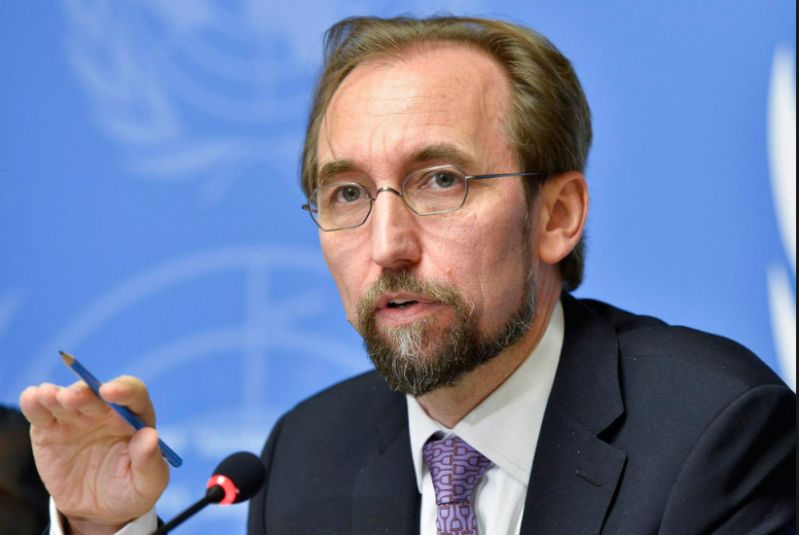
"I appealed to her to bring these military operations to an
end," he said. "I appealed to her emotional standing… to do whatever
she could to bring this to a close, and to my great regret it did not seem to
happen."
The UN rights chief believes Myanmar's army was emboldened when it saw
no international response to the operations against the Rohingya: "I
suppose that they then drew a conclusion that they could continue without
fear."
Suu Kyi's defenders argue that in a country where the military remains
the real power, her ability to stop the campaign against the Rohingya is
limited.
But Al Hussein makes the same observation several others have made: that
Suu Kyi tellingly refuses to even use the term "Rohingya" to refer to
the persecuted. "To strip their name from them is dehumanizing to the
point where you begin to believe that anything is possible," he said.
Myanmar and Bangladesh have agreed to send Rohingya people back to
Rakhine, in a deal that has been criticised by human
rights groups as premature and lacking safeguards for the persecuted minority.
But also known is that the local government has harvested the
crops of departed Rohingya farmers. Ministers have hinted at plans to
redistribute the land and no access has been given to independent
observers.
“Currently, people are still fleeing from Myanmar to Bangladesh and those
who do manage to cross the border still report being subject to violence in
recent weeks,” said MSF’s Wong. “With very few independent aid groups able to
access Maungdaw district in Rakhine, we fear for the fate of Rohingya people
who are still there.”
In a death rattle of democratic principles, Suu Kyi and
Commander-in-Chief Senior General Min Aung Hlaing have synchronized denials
over the scale of the carnage in Rakhine state in a series of speeches.
The world was somewhat aghast when broken her silence on spiraling
abuses against the Rohingya Muslim minority, described as “ethnic cleansing” by
UN officials, only to defend the government that she is part of, sparking
fierce criticism from former friends, allies and supporters.
“It
is incongruous for a symbol of righteousness to lead such a country,”
Archbishop Desmond Tutu said in a letter to his “dearly
beloved younger sister”. He’s the latest of several Nobel peace prize
winners to publicly rebuke their fellow laureate. “If the political price of
your ascension to the highest office in Myanmar is your silence, the price is
surely too steep,” he said.
Already in previous years, the Myanmar government has effectively
institutionalized discrimination against the ethnic group through restrictions
on marriage, family planning, employment, education, religious choice, and
freedom of movement. For example, Rohingya couples in the northern towns of
Maungdaw and Buthidaung are only allowed
to have two children. Rohingya must also seek permission to marry, which
may require them to bribe authorities and provide photographs of the bride
without a headscarf and the groom with a clean-shaven face, practices that
conflict with Muslim customs. To move to a new home or travel outside their
townships, Rohingya must gain government approval.
Like so many others who knew Aung San Suu Kyi during her struggle, and
millions more who admired her, Tutu seems almost as baffled as he is disturbed
by her stance. But as was
evident in a 2003 interview it was not the first time Suu Kyi gave air to
her prejudice in this case.
Also an incident at the very beginning of this year set the tone for an
annus horribilis in the assassination of respected lawyer Ko Ni, architect of
the NLD’s constitutional reform efforts. Ko Ni was shot in the head at Yangon
Airport while he was holding his grandson. The military-linked suspect was last
seen in the capital Naypyidaw.
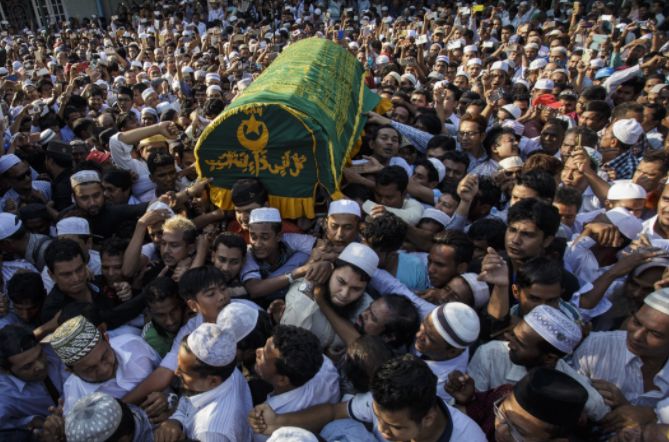
Suu Kyi did not attend Ko Ni’s funeral or visit his family in downtown
Yangon in the days after the killing, a widely criticized snub which put the
already rattled Muslim community in the city on edge. Ko Ni was a Muslim but
not a prominent activist for Rohingya rights and was seen more as a principled
advocate for constitutional and political reforms.
We also know that Suu Kyi was well informed and even engaged what the
recent developments concerns. For example on 9 August 2017, the
commander-in-chief and other senior military officers met with leaders of the
Arakan National Party, the largest party in Rakhine State – a rare meeting
between the top brass and a political party. The party expressed concerns about
the security situation in northern Rakhine and requested the arming of local
Rakhine Buddhist militias. That same day, State Counsellor Aung San Suu Kyi
convened a ministerial meeting on the security situation in Rakhine to discuss
the recent killings and rising tensions. The following day, the government
highlighted its deployment of some 500 troops to northern Rakhine to reassure
local non-Muslim villagers and conduct patrols in the mountains between
Maungdaw and Buthidaung where militants were
suspected of having established training camps.(1)
A brutal military response that failed to discriminate between ARSA
militants and the general population, followed by continued insecurity and
restrictions that have imperiled livelihoods, has driven more than 624,000
Rohingya into Bangladesh. This is one of the fastest refugee exoduses in modern
times and has created the largest refugee camp in the world. A large proportion
of Rohingya villages in the area have been systematically reduced to ashes by
both troops and local Rakhine vigilante groups that were equipped and supported
by the military.
This whereby security forces earlier drove out almost every aid group
from conflict areas in Rakhine’s Maungdaw district and only desultorily granted
access to the steadfastly neutral International Committee for Red Cross. ICRC
has operated in an almost lunar landscape of de-population where a senior ICRC
official recently observed “life
has stopped” for those left in the area.
The government compounded this disdain for foreign humanitarian actors
by charging them with complicity in support of ARSA militants, an affront to
their professional impartiality and a sop to Rakhine nationalist rhetoric that
routinely falsely alleges that international aid workers only assist Muslim
communities.
Conflicting scholarship on the
issue
The first one runs into when trying to research the above subject is the
positioning of an analysis in the safety of the center, he is careful to avoid
any real commitment to the people who are suffering. But the center is a
relative concept and the center for the analyst is far different to the center
of the people involved in the conflict. The scholarly researcher thus often
constructs the center by putting two things alongside each other as if both
have equal and exactly opposite power to determine outcomes. The Rakhine
against the Rohingya; the tenacity of the Rohingya to protect their
self-identification vs the Rakhine and Burmese tendency to denounce it.
Take, for instance, the NGO CDA’s 2016 Reshaping
Engagements: Perspective on Conflict Sensitivity in Rakhine State. Despite aiming “to serve as a platform to
build common understanding across stakeholder groups on the current conflict”
and “provide a basis for joint action”, the report does not actually consider
the perspective of Rohingya. In fact, it does not even mention the word
‘Rohingya’ preferring to simply use the term ‘Muslims’. The report mentions nothing of ethnic
cleansing, or the long history of state exclusion of the Rohingya. Instead, it
focuses on ‘breakdowns in communication’ and ‘competing agendas’. The author
has since gone on to publicly
defend the military and Aung San Suu Kyi. In
another conflict analysis produced by the Harvard Kennedy school for
Proximity Designs, the author similarly nervously approaches the subject of
ethnicity, noting that Rohingya is a ‘controversial’ title and preferring to
use the term ‘Muslim’. Although acknowledging that ‘Muslims’ and Rakhine are on
unequal footing, the report still falls into the bi-polar Buddhist-Islam
modality while barely touching on the role of the state and capital – “[W]ith a lack of many close links between the Muslim and
Buddhist communities, the recent violence has further frayed any trust… It is
difficult on the Burmese side to fully recognize this lack of parity of damage.
It is difficult for the Muslim side to admit that their actions have, at times,
also inflamed the situation.’ Another
major project on conflict analysis from Deakin University Australia also
insists on using inverted commas when talking about the Rohingya. Once again,
the research predominantly focuses on the grievances of Buddhists and Muslims
and ways for improved engagement.
What is also remarkable about the Rohingya crisis and what makes it
unique in comparison to the long list of historic ethnic insurgencies is the
way in which the Central Burmese called Bamar have
organically rallied around the government and military. From anti-government
rallies, the last year has for the first time seen mass pro-government rallies.
So too, large numbers of Bamar across many classes
have been involved in online harassment campaigns of anyone who opposes the
brutal treatment of the Rohingya.
Many of the conflict analyses share an intellectual cynicism about the
Rohingya ethnic category. Influenced by this kind of work, several pieces have
criticized the Rohingya for their insistence on self-identification. As the
Burmese and Rakhine are trying to violently exclude Rohingya from Myanmar in a
physical and cultural sense, some western intellectuals have continued to
unhelpfully question their right to self-identification.
For example, Harvard university student wrote
in the Diplomat “[I]n even a cursory survey of Rohingya history, it is
clear that the Rohingya are not an ethnic, but rather a political
construction…. At stake are issues of legitimacy. The international community’s
use of the term ‘Rohingya’ validates the narrative of essentialising
a Muslim identity in Rakhine state”.
They argue that despite a general understanding that a part of the
Arakan Muslims had deep roots in the country and that Rakhine history cannot be
understood without its social and religious complications with Bengal from the
past down to the present, a pervasive Rakhine narrative about Muslims in Arakan
has viewed them as ‘guests’ who have betrayed the trust of their hosts by
claiming territorial ownership. The claim of a distinctive ethnicity made by
Rohingyas is, therefore, considered by them as fake.
Many such analyses give a pseudo sense of complexity that seeks to water
down murderous ethnic cleansing and deny any political urgency. By maintaining
a centrism that can supposedly see all sides, the liberal analyst can always
claim the situation is complex and nuanced." Convoluted analyses that deny
this immediacy and criticise the actions of the
Rohingya are politically feeble.
No one will argue
that decolonizing the category “Rohingya” is today’s most urgent task. Yet it
seems significant that information like the above have been shared, posted, and
circulated among defenders of Daw Suu and the military’s actions in Rakhine.
Thus history has its
limits in the context of humanitarian crisis, perhaps especially so when
debates over history hinge on questions of identity.
Thus rather than
obscuring the forces and processes that allow large scale violence to occur, it
is urgent to keep these forces and their effects at the center
of accounts of the unfolding tragedy. The way events are framed and talked
about have important political ramifications at all levels. It is the political
feebleness of analysis that makes it ideal as a discursive tool on the part of
so many states and actors that wish to remain apathetic towards the Rohingya
cause.
Noteworthy is also that the 1978
“Repatriation
Agreement” with Bangladesh and
published by Princeton
University in 2014 constitutes evidence that in 1978, Myanmar acknowledged
that most Rohingya in 1978 still had
national registration cards or other documents, and thus were by and large
“lawful residents of Burma.”
The Four Cuts Strategy
revisited
The groundwork for the current catastrophe, however, had already been
laid. Since the 1970s, the Tatmadaw has carried out with impunity a “Four Cuts”
campaign against other ethnic populations, cutting off food, funds, and
information. The first reference to information
about what resulted from the “Four Cuts” was published in 2005.
The four cuts strategy was applied first in the Naga hills, and then
most devastatingly in the Shan and Karen States.The
cuts strategy involved gross human-rights abuses, including the well-documented
rape of women, torture, summary executions and more. Many witnesses have also
testified to the use of conscripted labor and the employment of civilians and
prisoners as human minesweepers. Some have suggested that it was the very
implementation of the four cuts strategy that drove the Myanmar armed forces
(Tatmadaw) to the depths of barbarity and callousness for which it has become
notorious. Others argue that such was the feeling of racial animosity against
the Karen, Kachin, Rohinghya, and other ethnic groups among the Burmese that
the Myanmars’s (Tatmandaw)
soldiers were perfectly happy to prosecute the dreadful strategy from the
start. Far from a relic of the past, this policy-which
largely victimized civilians-was officially reinvigorated in 2011, and as we
see below took on a turn for the worst in 2017 when we see what happened to the
Rohinghya villages during the 2017 campaign:
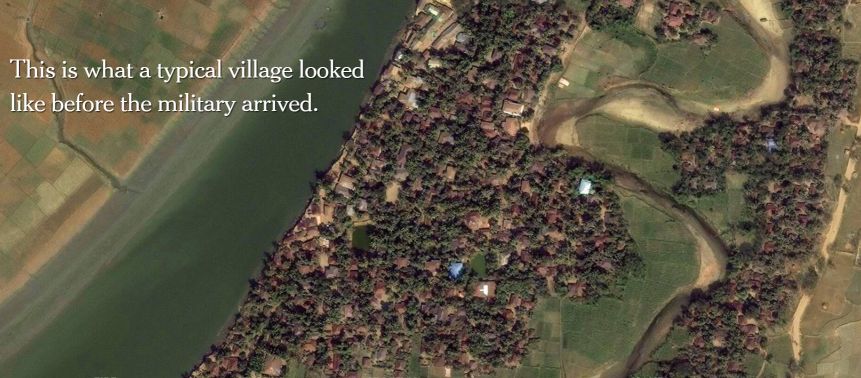
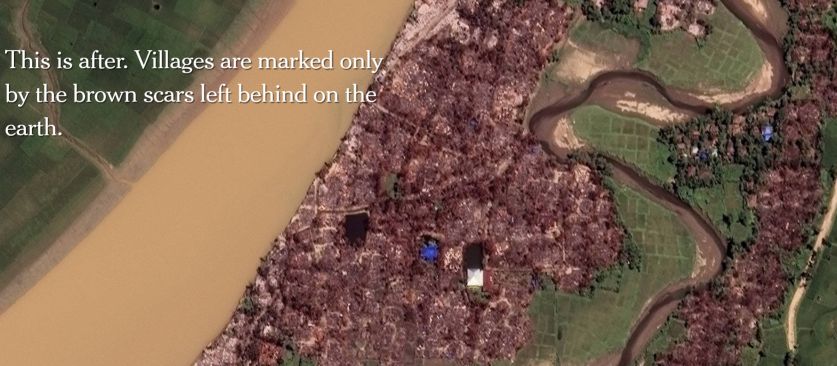
During the recent ‘clearance operation’ over
350 villages were burned down, and, according to conservative estimates by
Docter Without Borders, 6,700 people may have been killed by security
forces and vigilantes. The number of defamation cases against journalists also
spiked in 2017. Many local reporters are now operating in a climate of fear
under the elected National League for Democracy (NLD)-led government,
undercutting hopes it would champion, not repress, free speech in line with its
democratic mandate after decades of censorship under military rule.
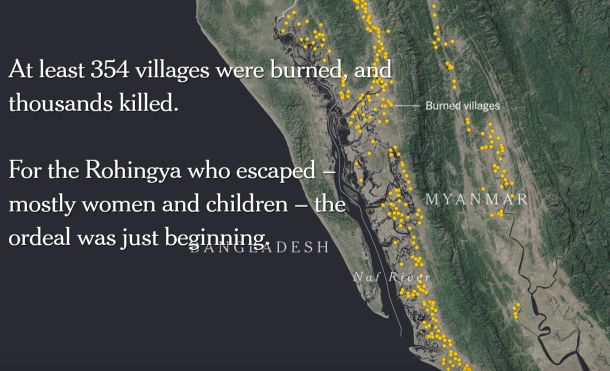
Grim details of the military and local vigilante campaign of violence,
described by the UN as “a textbook example of ethnic cleansing” (a characterisation that has now been echoed by the United
States) and by human rights groups as crimes against humanity, have been set
out in a series of detailed reports by these organisations.
They document widespread, unlawful killings by the security forces and
vigilantes, including several massacres; rape and other forms of sexual
violence against women and children; the widespread, systematic, pre-planned
burning of tens of thousands of Rohingya homes and other structures by the
military, BGP and vigilantes across northern Rakhine State from 25 August until
at least October 2017; and severe, ongoing restrictions on humanitarian
assistance for remaining Rohingya villagers.(2)
Myanmar
and Bangladesh signed a repatriation agreement on 23 November 2017 in
Naypyitaw. While it was politically expedient for both sides, Bangladesh to
signal that it will not host the refugees indefinitely, and Myanmar to respond
to charges of ethnic cleansing and ease pressure for action.
It should be noted however that Myanmar has consistently declined any
role for the UN Refugee Agency, which could mobilise
the necessary support as well as credibility in the eyes of the Rohingya and
internationally; the bilateral agreement does not require it.(3)
Beyond the risk of further abuses against the Rohingya, the authorities
have reinforced an ugly strand of nationalism that will outlast the current
crisis and could be channelled to target other
minorities. At a minimum, it will be more difficult for national leaders to
make the necessary concessions in the peace process of greater minority rights
and political and economic devolution. To this one could ad that ARSA is not
(and likely never will be) part of the peace process, given that the Rohingya
are not a recognized ethnic group.
Myanmar set its political direction early in the crisis, and, so far,
international scrutiny, pressure and diplomatic engagement has brought about no
meaningful change – not even seemingly minor concessions such as allowing UN
humanitarian access to the area or signalling
openness to international support or advice. Extremely strong domestic
political consensus on this issue has united the government, military including
in this case, a majority of the population as never before in Myanmar’s modern
history.
Reports also document
the mass rape of women and girls, some of whom died as a result of the
sexual injuries they suffered. It shows how children and adults had their
throats slit in front of their families, also
here. Skye Wheeler, the above listed researcher for Human Rights Watch who
is one of those that investigated the sexual violence allegations, said Myanmar
was denying a “terrible truth”. “The lack of acknowledgement or care the
Myanmar authorities including Aung San Suu Kyi have shown for Rohingya women
and girls who have been brutally raped by Myanmar soldiers as part of their
ethnic cleansing campaign is almost as shocking as the horrific crimes
themselves,” she said.
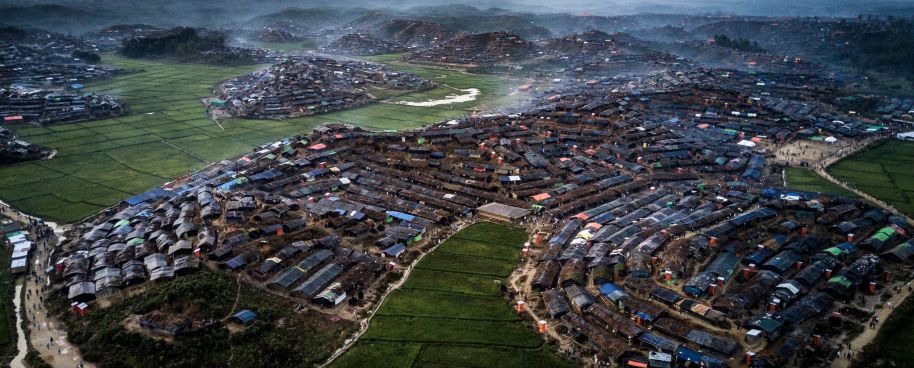
Thus in spite of the dire conditions in Bangladesh, worse could be to
move these people from camps in Bangladesh to camps in Myanmar. Whereby one of
the problems is that given no great power interests are going to be served in
saving the Rohingyas, in spite of some financial donations for that purpose
credible help for these people in Myanmar seems improbable.
This said, neither the
government nor security forces possess the political will to create conditions
for voluntary return and implement a credible and effective process to that
end. This raises the prospect of a long-term concentration of hundreds of thousands
of traumatized Rohingya confined to squalid camps in Bangladesh, with no
obvious way out or hope for the future.
The Chinese friend is back
But it is not only the trouble with the Rohingya, to date, 80% of armed
non-state actors have refused to sign the NCA, which they view as tantamount to
surrender without any guarantees of self-determination. And there is no sign
that the government or military is willing to soften that hardline stance,
making a farce of Suu
Kyi’s 21st Century Panglong initiative as an inclusive and equal forum for
peace.
Myanmar won its independence from British
colonial rule in 1948. Sadly its history since
then has been massively unhappy. From being the best educated (apart from
Japan) country in East Asia, it spiraled down over the ensuing 65 years to
being possibly the worst educated as well as one of the poorest. The primary
cause of this decline was the world’s longest continuing civil war in which the
ethnic Bamar Buddhist majority in the central valley
has sought to dominate dozens of non-Buddhist ethnic
minorities inhabiting the mountainous borderlands.
The Bamar (Burmese) Buddhist majority
maintained its control of the heartland by extracting natural resources,
including natural gas from offshore fields that it began exporting to Thailand
around 2000 and to China around 2014. Whereby the ethnic minorities have been
able to smuggle enough resources to neighboring China, Thailand, and India to
obtain the weapons required to defend their territories against the
government’s army.
Successive military leaders have belittled, denied and squelched the
grievances of ethnic minorities, including (as seen above) chronic complaints
of military abuses and insensitivities that have perpetuated armed conflict.
A major sticking point in ongoing negotiations between the Myanmar
government, the autonomous military and the nation’s many ethnic armed groups
concerns how much autonomy should be granted to frontier areas and how that
devolution of power should be distributed among various ethnic groups.
Internal sources are telling me that with the offensive against the
Rohingya now completed, Myanmar’s military troop movements show they might be
preparing, among others, a new offensive against the Kachin Independence Army
(KIA), an armed ethnic organization that has been fighting on-and-off for
decades for self-determination. See also
here, and here.
Number of Kachin people living in Myanmar, or about 1.5% of the
country’s total population. Most live on the government-controlled
side of Kachin state, where their language and culture are strictly policed.
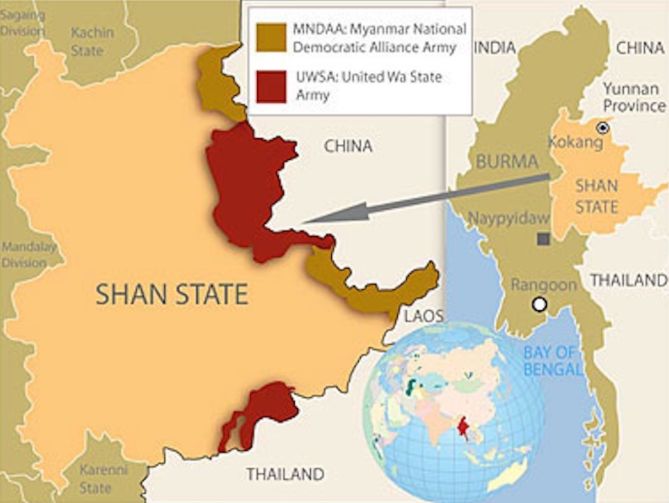
But China no doubt pleased by the turn of events in 2017. The year 2017
was a momentous one for China in so far as regaining its ground in Myanmar is
concerned. China not only leveraged its salience in the ongoing peace and
reconciliation process but also took advantage of Myanmar's difficulties with
the UN and the Western countries on the Rohingya crisis. Further, Beijing was
able to push Aung San Suu Kyi-led government to be part of its ambitious Belt
and Road Initiative.
Naypyidaw appears to hope that China can be persuaded at least to stay
the hand of ethnic forces. An unusual report
released by the Tatmadaw on December 22 asserted that joint ethnic Palaung Ta’ang National Liberation Army and Kachin Independence Army forces had attacked
security posts along the key oil and gas pipelines that run through
northwestern Shan state into China.
Claiming that the attacks were specifically intended to “damage the
relationship between Myanmar and China”, the report pointedly implied that the
ethnic groups were recklessly targeting the security of the pipelines and
thereby endangering China’s strategic interests.
However, none of the ethnic groups in the region has ever displayed any interest in threatening the pipelines
either during their construction or since, and it is difficult to see why
that might change today.
While admitting that the Tatmadaw had clashed with its forces in Namhkam township near the Chinese border through which the
pipelines pass, and with KIA in Bhamo in neighboring Kachin State, the TNLA was
quick to deny there had been any joint operation or that fighting had
endangered the pipelines.
More broadly, given deep mistrust and a yawning rift
between Naypyidaw and the Federal Political and Negotiating Consultative
Committee (FPNCC) over the National Ceasefire Agreement (NCA) , it would be
naïve to imagine Beijing can persuade either side to exercise significant
restraint. Indeed, there exists a real possibility that continued skirmishes
may provide a pretext or indeed real grounds for yet another coordinated
counter-offensive by the FPNCC’s northern alliance.
High-level state visits from the United States, first by then Secretary
of State Hillary Clinton in late 2011, and then President Barack Obama a year
later, and other Western countries brought Myanmar out of isolation, quickly
turning the country from an international pariah to a darling of the West.
Myitsone and other bilateral issues, meanwhile, led to a nationalistic
rise in anti-Chinese sentiment among the population and in media reports. But
2017 was the year that China bounced back to re-emerge as Myanmar’s closest and
most trusted political ally.
After a few years of “soft diplomacy” – including sponsorship of
all-paid junket trips for Myanmar politicians and journalists and contributions
to state infrastructure projects – the turning point came during the Rohingya
refugee crisis, which started in late August.
While the West strongly condemned and slapped punitive measures on the
Myanmar military for extreme human rights abuses during so-called “clearance
operations”, China kept mostly quiet while pledging to block any attempts by
the UN Security Council to impose punitive sanctions.
Then, in November, Myanmar Commander-in-Chief Senior General Min Aung
Hlaing visited China, where he was received by President Xi Jinping and other
leaders. A couple of weeks later, Suu
Kyi also traveled to Beijing for a state visit where Xi asserted that China
is “committed” to “friendly ties” with Myanmar.
Myanmar’s attempts to find a solution to its long-running ethnic wars
have also seen China emerge as a lead actor, sidelining a host of Western
initiatives and outfits that have been involved in the peace process since
Thein Sein assumed the presidency in March 2011.
Only China has close connections with the
ethnic armed groups in the north that have refused to sign the NCA, including the heavily armed and influential United Wa State Army (UWSA), and is thus the only viable
foreign interlocutor in the peace process.
List of Main
Ethnic Armed Groups and their Ceasefire
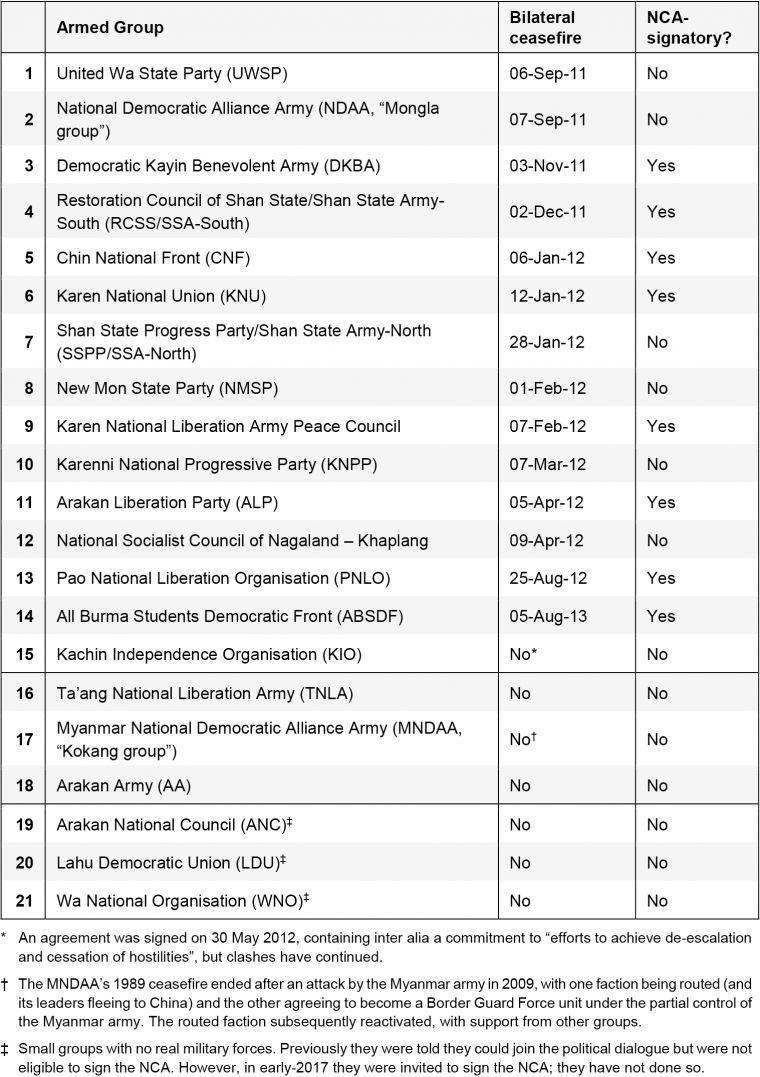
All in all, China is increasingly seen as a “friend in need” at a time
Myanmar feels it is under new and unfair assault from the West and United
Nations. And there are certain indications that perceived as friendly
commitment will be rewarded with a new raft of economic concessions.
While the controversial Myitsone dam was not mentioned during Suu Kyi’s
visit to China, it is hardly a secret that Beijing would like to see the
suspension lifted and the project to be completed as planned when it was first
outlined in 2001.
China’s interests in Myanmar, of course, extend beyond electric power,
ethnic wars and refugees. Myanmar is China’s main outlet to the Indian Ocean,
where the Kyaukphyu port in Rakhine state and
pipelines provide a strategic hedge for its fuel and other shipments that could
be blocked at the Malacca Strait chokepoint in a conflict situation.
Myanmar is crucial corridor in
China’s US$1 trillion ‘One Belt, One Road’ global infrastructure
development initiative. In October, Minister for Construction Win
Khaing said at a forum in Singapore that “we are talking about how to
complement such [Obor] initiatives because [its]
objectives can very well complement our national objectives.”
Several other countries in the region are starting to view Obor-backed projects with apprehension and suspicion, but
Myanmar appears now to be a willing partner in the ambitious scheme.
How all these diplomatic dynamics will play out in 2018 and beyond
remains to be seen. But China is now firmly back and with a vision to stay in
Myanmar.
While in Western countries on the other hand, Myanmar’s allure as Asia’s
final frontier might have been irreparably tarnished, while the many policy
priorities of the elected National League for Democracy (NLD) government might
have been imperiled over its incompetent and pitiless response to for example
the Rakhine state crisis.
Update 2
Febr. 2018: Today there are new reports about five
mass graves. Yanghee Lee, the United Nations’
special envoy on human rights in Myanmar, said mounting evidence of atrocities
in Rakhine bear “the
hallmarks of genocide." Earlier veteran US politician Bill Richardson
said from first hand experience that Aung San Suu Kyi
lives
in 'bubble'.
1. See Senior General Min Aung Hlaing, Facebook post, 10 August 2017, http://bit.ly/2yqQYSA; “State Counsellor,
Union Ministers hold talks on security in Rakhine State”, GNLM, 10 August 2017;
“Myanmar Army Deployed in Maungdaw”, The Irrawaddy, 11 August 2017.
2. See, in particular, Amnesty International, op. cit., as well as “Destroyed areas in Buthidaung,
Maungdaw, and Rathedaung Townships of Rakhine State”,
UN Institute for Training and Research (UNITAR)/UNITAR’s Operational Satellite
Applications Programme (UNOSAT) imagery analysis, 16
November 2017; “Burma: New Satellite Images Confirm Mass Destruction”, Human
Rights Watch, 17 October 2017; “Mission report of OHCHR rapid response mission
to Cox’s Bazar, Bangladesh, 13-24 September 2017”, OHCHR, October 2017; “U.N.
sees ‘textbook example of ethnic cleansing’ in Myanmar”, Reuters, 11
3. Crisis Group interviews, Rohingya refugees, Bangladesh,
September-November 2017; “Sales from Maungtaw paddy
kept as national budget”, GNLM, 12 November 2017; “Govt Suggests Possible Daily
Repatriation of 300 Rohingya Refugees”, The Irrawaddy, 30 October 2017;
“Tensions over Rohingya return highlight donor dilemmas”, Nikkei Asian Review,
27 October 2017; “Returning Rohingya may lose land, crops under Myanmar plans”,
Reuters, 22 October 2017; “‘Caged Without a Roof’: Apartheid in Myanmar’s
Rakhine State”, Amnesty International, 21 November 2017.
For updates click homepage
here